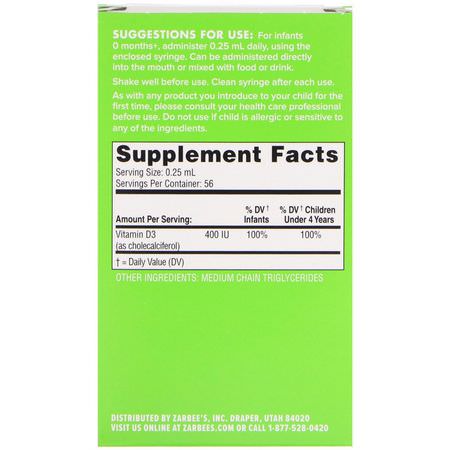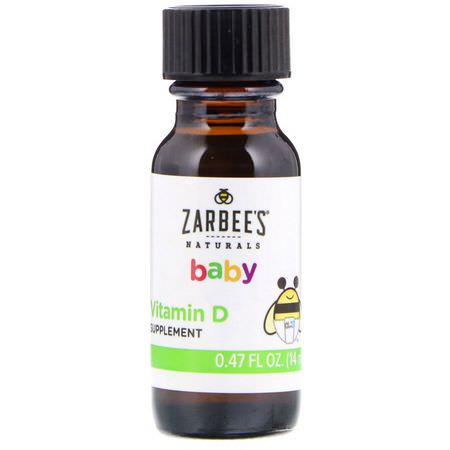Foodpharmacy Blog: Kids, Baby, Children's Health, Children's Vitamin D
Zarbee’s, Baby, Vitamin D, 0.47 fl oz (14 ml)

$8.40
Product name: Zarbee’s, Baby, Vitamin D, 0.47 fl oz (14 ml)
Quantity: 0.47 fl oz, 0.05 kg, 9.7 x 5.8 x 4.1 cm
Categories: Zarbees, Baby, Kids, Children’s Health, Children’s Vitamin D, No Artificial Flavors, No Artificial Sweeteners, Gluten Free
Naturals, Supplement, Supports Strong Bone and Teeth Development, Safe and Effective, Essential for Breastfed Infants, Pediatrician Recommended, No Drugs or Alcohol, No Dyes, No Artificial Flavors, No Artificial Sweeteners, Gluten-Free, Safe and Effective, Delivers 400 IU of vitamin D as recommended by the American Academy of Pediatrics (AAP), especially for breastfed infants, Helps infants and toddlers absorb calcium for strong bones and teeth, Zarbee’s Story, Dr. Zak Zarbock a pediatrician and father, couldn’t find effective chemical-free products to keep the whole family healthy, so he created his own products, including handpicked natural ingredients, whenever possible. The result is Zarbee’s Naturals.

See overview of vitamin d, section on metabolism’). Kids optimal multivitamin by seeking health is a comprehensive multivitamin and mineral supplement that is specifically designed to support the nut. Protease inhibitors inhibit the cytochrome p450 enzyme system and decrease the production of active vitamin d (Calcitriol). Generally speaking, levels of at least 30 ng/ml (75 Nmol/l) appear safe and reasonable for children with chronic disease, and additional research is confirming whether this range is appropriate for other pediatric groups as well. Much debate and uncertainty surround how much (If at all) healthy infants, children, and adolescents should be supplemented with vitamin d. Two hundred and forty-five healthy infants, aged between 6 and 24 months, followed at two near municipal primary health care units, were invited to participate. In the kidneys and other organs, 25-(Oh)d changes into the active form of vitamin d, called calcitriol. See vitamin d deficiency and rickets for more information. That’s why the department of health recommends that all children aged 6 months to 5 years are given vitamin supplements containing vitamins a, c and d every day. In all, 154 deaths from cancer occurred in the vitamin d group versus 187 in the placebo group. Talk to your pharmacist about which supplement would be most suitable for your child. Vitamins are usually unnecessary for healthy children eating balanced diets.
Zarbee’s, Baby, Vitamin D, 0.47 fl oz (14 ml): Children’s Vitamin D, Children’s Health, Kids, Baby
Once you have selected a supplement and received your order, read the directions provided by the manufacturer carefully and follow them closely unless otherwise directed by your health care provider. Knowing that there is an interaction between calcium intake and vitamin d status, changes in calcium intake may exacerbate or attenuate the nr. Although the body can create vitamin d, a deficiency can occur for many reasons. Do breastfed infants need supplemental vitamins? Cholecalciferol or vitamin d 3 is produced from 7-dehydrocholesterol in the skin by exposure to sunlight. Relationship between vitamin d, parathyroid hormone, and bone health. Trade associations will tell you supplements are a regulated industry, but because it is self-regulated, it’s essentially unregulated, says sarah erush, clinical manager of the pharmacy department at the children’s hospital of philadelphia. The classical skeletal features include bony swelling at the wrists, knees, ankles and costochondral junction (Rachitic rosary), and in mobile children bending of the limbs might be observed. Some parents also perceived that the vitamin d information was not appealing and eye catching in appearance.

Can food vouchers improve nutrition and reduce health inequalities in low-income mothers and young children: A multi-method evaluation of the experiences of beneficiaries and practitioners of the healthy start programme in england. According to the national institutes of health, kids between 4 and 8 require 25 milligrams of vitamin c every day. Nutrients that help build bones and promote brain development are especially significant in childhood. Breastfed babies in particular often need an extra dose of vitamin d, and these baby ddrops make it easy to give it to them. The importance of vitamin d: Information about how vitamin d relates to health, including information about strong bones and teeth and the department of health vitamin d recommendations. 17 Patient characteristics such as baseline calcidiol concentration, polypharmacy, and sun exposure should help guide vitamin d therapy as well. A healthy diet for kids should also limit added sugars and highly processed foods and focus on whole fruits over fruit juice.
G, calcium and phosphorus deficiency, inherited forms of hypophosphatemic rickets, and vitamin d receptor mutations); however, these etiologies will not be discussed in this review. G, glucocorticoids, cytochrome p450 3a4 inducers, anticonvulsants, and anti-retroviral agents) has also been associated with compromised vitamin d concentrations. There has also been a piquing interest in vitamin d in pediatric patients due to the recent epidemiologic reports suggesting that vitamin d may protect against autoimmune disease and play a role in innate immunity. Meaning under the current public health england or department of health recommendations, 158 respondents out of the total sample of 194, should be giving their child a vitamin d supplement. Davis says testing is tricky because the vitamin goes through several steps to get to it’s active form. 1 Preterm infants are more likely to be vitamin d deficient since their transplacental transfer from the mother was a shorter duration, hospitalization leading to a negligible amount of uv-mediated vitamin d formation, and possibly lower vitamin d stores due to a lower fat mass. It is known that activated vitamin d blocks cells at the g-1 phase, modulates production of several pro-oncogenes, and promotes apoptosis in some forms of cancer. While the season of the year and race/ethnicity did not emerge as predictors of vitamin d insufficiency, breastfeeding without supplementation and lack of milk consumption did. Chewable vitamins are small pills that break down into a powder as your child chews for easy swallowing.
Effect of oral cholecalciferol 2,000 versus 5,000 iu on serum vitamin d, pth, bone and muscle strength in patients with vitamin d deficiency. The nih reports that kids between 1 and 3 should get about 2,000 international units of vitamin a every day; and for kids 4 to 8, 3,000 ius. Severe deficiency of vitamin d causes rickets in infants and children, and osteomalacia in all age groups. Congenital rickets due to vitamin d deficiency in the mothers. Vitamin d plays an essential role in maintaining bone health through regulating calcium concentrations in the body. These factors are vital for maintaining healthy bones. Yet, only 26% of the sample reported giving their youngest child a vitamin d supplement on most days of the week. Whilst others thought that both a more positive message and a risk message about the health effects of vitamin d would encourage more people to increase their vitamin d intake. Current treatment recommendations for correcting vitamin d deficiency in pediatric patients with cystic fibrosis are inadequate. The upper limit that healthcare professionals recommend for vitamin d is 4,000 iu per day for an adult. Unless your child has a specific medical condition which requires supplementation, it is best to wait until a child reaches the age of four before giving him or her a multivitamin supplement. The biggest offender of which is flinstones chewable vitamins. If you suspect that your child has taken too much of a vitamin or mineral supplement, contact a healthcare provider immediately.
Zarbees Children’s Vitamin D
A review on vitamin d deficiency treatment in pediatric patients. Among older children and adolescents, anorexia nervosa is also a risk factor for inadequate vitamin d levels. For best results, we recommend choosing a multivitamin product that has an overall effectiveness score of 8,0 and above. For example: If you live in a far northern latitude, if you live in an urban area where tall buildings and pollution block sunlight, if baby is always completely covered and kept out of the sun, if baby is always inside during the day, or if you always apply high-spf sunscreen. This page may be photocopied noncommercially by physicians and other health care professionals to share with patients. Serum 25-hydroxyvitamin d levels among us children aged 1 to 11 years: Do children need more vitamin d? Studies are now testing whether adding various doses of vitamin d to regular treatments can help people with ms. The reduced pigmentation of light-skinned individuals may result in higher vitamin d levels and that, because melanin acts like a sun-block, dark-skinned individuals, in particular, may require extra vitamin d to avoid deficiency at higher latitudes. Vitamin d (Vd) is one of the fat-soluble vitamins. Most children’s multivitamins are flavored, making them pleasing to kids Palates. Providing vitamin d can prevent and treat this problem.
Vitamin d deficiency: A worldwide problem with health consequences. Types of foods and drinks fortified with vitamin d. Although supplementation with calcitriol does not replete vitamin d stores, it may be an option for cf patients unresponsive to vitamin d 2 and d 3 to manage consequences of vitamin d deficiency. Additionally, of the children who also had asthma, only 2 in the study group vs. In children and adolescents, vitamin d excess was rare and usually asymptomatic. Another study comparing daily, weekly, and monthly supplementation of vitamin d in deficient patient was published by takacs et al. Although vitamin d toxicity is rare in children, increased use of vitamin d formulations, re-examination of optimal vitamin d levels, and use of higher doses lend potential for an increased incidence of vitamin d toxicity. The drugs and therapeutics committee of the pediatric endocrine society suggests obtaining serum 25-hydroxyvitamin d levels in infants and children who receive long-term vitamin d supplementation at or above the upper level intake that is currently recommended. However, there is evidence to suggest that in pregnancy this may be insufficient to achieve vitamin d replete status in many women. Because the vitamin d content in human breast milk is low, breastfed infants typically develop low vitamin d levels unless they receive supplementation or plenty of exposure to sunlight.
Empirical therapy of vitamin d deficiency with high vitamin d doses, such as stoss therapy, is discouraged without previous documentation of 25ohd concentrations and monitoring of 25ohd and serum calcium levels. A systematic review published in the cochrane library looked at children up to three years old in turkey and china and found there was a beneficial association between vitamin d and rickets. Cognitive dissonance runs rampant in the health care professions. Being aware of the risk factors associated with the development of vitamin d deficiency will help guide clinicians to both assess for and intervene with supplementation as needed. Evidence of vitamin d supplementation in children and adolescents with sickle cell disease are limited. The benefit of adequate vitamin d has also been demonstrated in children with asthma, eczema, and allergies. If you notice your child seems less active than usual or has trouble learning, ask your pediatrician to test for iron deficiency. The replacement of vitamin d has been proven to correct rickets using these methods of ultraviolet light therapy and medicine.
When choosing a vitamin, look for high-quality brands and supplements that contain the appropriate dosages of vitamins and minerals for children.